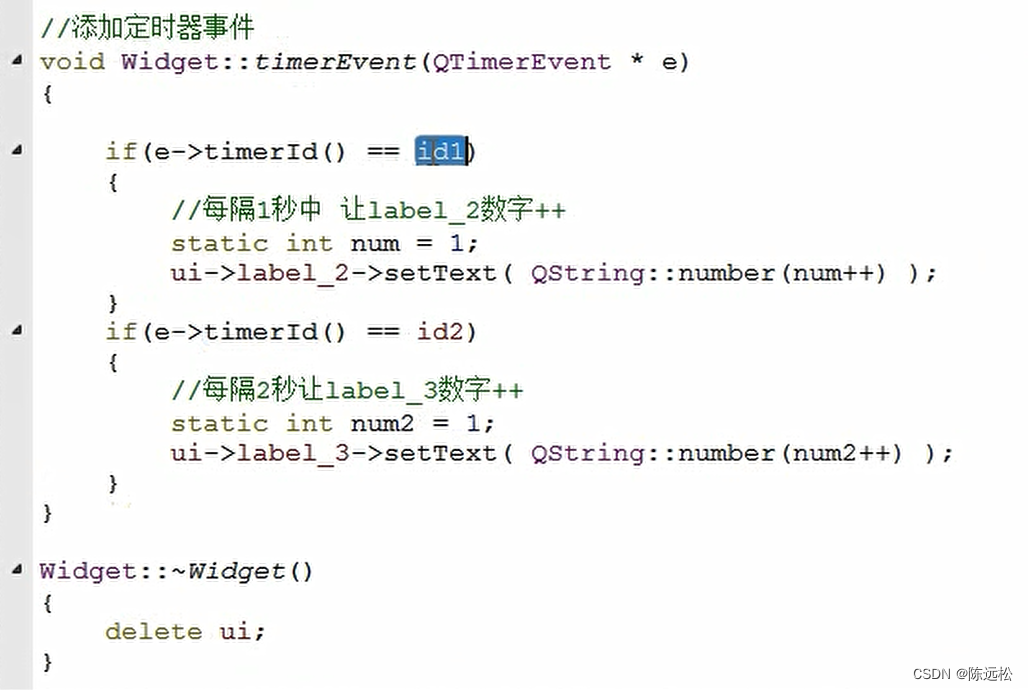// 指定了父对象, 创建的堆内存可以自动析构
QTimer::QTimer(QObject *parent = nullptr);
// 根据指定的时间间隔启动或者重启定时器, 需要调用 setInterval() 设置时间间隔
void QTimer::start();
// 启动或重新启动定时器,超时间隔为msec毫秒。
void QTimer::start(int msec);
// 停止定时器。
void QTimer::stop();
//当定时器超时时,该信号就会被发射出来。
[signal] void QTimer::timeout();
// 设置定时器时间间隔为 msec 毫秒,默认值是0。
void QTimer::setInterval(int msec);
// 获取定时器的时间间隔, 返回值单位: 毫秒
int QTimer::interval() const;
void QTimer::setTimerType(Qt::TimerType atype); // 设置定时器的精度
参数:
- Qt::PreciseTimer -> 精确的精度, 毫秒级
- Qt::CoarseTimer -> 粗糙的精度, 和1毫秒的误差在5%的范围内, 默认精度
- Qt::VeryCoarseTimer -> 非常粗糙的精度, 精度在1秒左右
Qt::TimerType QTimer::timerType() const; // 获取当前定时器的精度
在这里插入代码片
// 如果定时器正在运行,返回true; 否则返回false。
bool QTimer::isActive() const;
// 判断定时器是否只触发一次
bool QTimer::isSingleShot() const;
// 设置定时器是否只触发一次, 参数为true定时器只触发一次, 为false定时器重复触发, 默认为false
void QTimer::setSingleShot(bool singleShot);

//设置界面实时时间
QTimer *timer = new QTimer(this);
timer->start(1000);//启动定时器
connect(timer, &QTimer::timeout, [=](){
QTime time = QTime::currentTime();//获取当前时间
QString str = time.toString("hh:mm:ss");
ui->label_curTime->setText(str);//显示到界面
});
[static] void QTimer::singleShot(int msec, const QObject *receiver, PointerToMemberFunction method);
功能: 在 msec 毫秒后发射一次信号, 并且只发射一次
参数:
- msec: 在msec毫秒后发射信号
- receiver: 接收信号的对象地址
- method: 槽函数地址
//延时300毫秒,切换窗口
QTimer::singleShot(300, this, [=](){// 延时300毫秒
this->hide();//隐藏主窗口
chooseScene->show();//显示其他窗口
});
返回定时器 Id

重写定时器事件,利用 定时器 id 判断是哪一个定时器

原文地址:https://blog.csdn.net/CYS_2020/article/details/134700412
本文来自互联网用户投稿,该文观点仅代表作者本人,不代表本站立场。本站仅提供信息存储空间服务,不拥有所有权,不承担相关法律责任。
如若转载,请注明出处:http://www.7code.cn/show_35562.html
如若内容造成侵权/违法违规/事实不符,请联系代码007邮箱:suwngjj01@126.com进行投诉反馈,一经查实,立即删除!